
* In 1927, an American aviation enthusiast named Clyde Cessna started up an aircraft company in Wichita, Kansas, building single-engine aircraft for the commercial market. Since that time, Cessna has continued to build single-engine civil aircraft. This document discusses the Cessna singles with taildragger landing gear; another document will discuss those with tricycle landing gear.

* Clyde Cessna was a Kansas farmer who got an itch to fly, buying a French-built Bleriot monoplane in 1911. After a rough learning curve, Cessna became an exhibition flyer, also becoming competent at rebuilding and revising his aircraft. In 1916, he moved to Wichita, to set up his own company to build his own derivative of the Bleriot, an air racer called the "Comet". The operation was largely supported by Cessna's profitable flight exhibitions.
When America declared war on Germany in 1917, Cessna -- too old to volunteer for duty -- hoped to train airmen for the conflict. Alas, the government wasn't supportive, and then shut down Cessna's exhibition flying by restricting fuel supplies. Cessna had to put his aviation business on the back burner, going back to his farm again.
In 1925, Clyde Cessna was contacted by two other aviation entrepreneurs, Walter Beech and Lloyd Stearman. The two, who had walked out of another aviation firm after disputes with the management, flew to his farm and convinced Cessna to join them in forming a new aircraft company, which soon emerged as the "Travel Aire Manufacturing Company" of Wichita. Cessna became vice-president of the firm.
The initial aircraft produced by Travel Aire were biplanes. Cessna, prejudiced by his Bleriot background to monoplanes, differed with Beech and Stearman in believing that monoplanes were more the way of the future. To push the point, he worked on a monoplane design in a shop that he rented himself, with the "Model 500" flying in 1926.
It was a boxy aircraft, made primarily of steel tubing with cloth covering, and with:
Walter Beech liked the design, believing it had potential as a mail carrier. The National Air Transport (NAT) Company was conducting a competition for such an aircraft; Beech and Cessna flew it to Kansas City for the contest and won, with National Air Transport ordering eight of them. These machines featured a Wright Whirlwind radial engine with nine cylinders and 165 kW (225 HP), along with a new tail, and only four seats; they were designated "Model 5000".
Only 13 Model 500 / 5000 machines were built in all, but in those days, aircraft development costs were modest, and that was enough to be successful. Indeed, the Model 5000 achieved some prominence in long-range record flights -- one flying from California to Hawaii in August 1927 under the infamous Dole Air Race. It was one of the only two out of eight contenders in the race that finished, with ten aviators lost in the exercise. Incidentally, NAT was bought out by Boeing in 1930, but the Air Mail Act of 1934 prohibited manufacturers and airlines from being under the same roof; Boeing split out its airline business, which became United Air Lines.
* Cessna wanted to improve on the monoplane design concept by introducing a "cantilever" wing -- that is, one without struts. That was ambitious and risky; Beech wasn't enthusiastic, but he encouraged Cessna to follow up the idea on his own. Cessna sold off his interest in Travel Air, to set up the "second coming" of the Cessna Aircraft Company in 1927.
Cessna focused on a cantilever design, the "All-Purpose", with a wingspan of 11 meters (36 feet). After aggressive testing of the new cantilever wing, the All-Purpose flew first, validating everything expected of it. It had the general configuration of the Model 500 / 5000, except for being smaller -- with three seats -- plus the cantilever wing, and no cross-bracing on the main gear. It was powered by an Anzani radial engine.
It is unclear how many Phantoms were made; some sources claim a dozen were built -- but it seems more likely to have been a single prototype, it being hard to find mention of the Phantom in anyone else's hands, or evidence that it ever got formal government certification.
Cessna continued to tinker with the machine, first fitting it with a Wright Whirlwind J-5 radial with 165 kW (225 HP), the machine doing well in air races. Cessna then enhanced the prototype with niceties such as more passenger windows, this aircraft becoming the basis for the Cessna "A-Series", with initial deliveries in 1928. Limited availability of the J-5 Whirlwind resulted in the Cessna A being sold with options for five different radial engines:
A total of 69 Cessna A machines was sold from 1928 to 1930, about two-thirds of them being AWs. One was flown by Clyde Cessna's son Eldon as an air racer, this aircraft being fitted with neat mainwheel spats and an engine cowling.
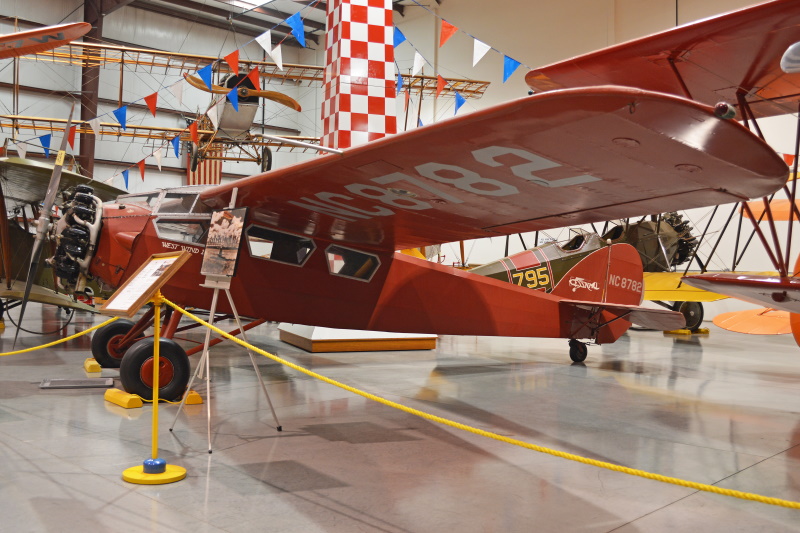
The A-Series design was sold with the J-5 Whirlwind as the "BW", the "W" standing for "Wright". Primarily due to a delay in certification, only 13 were sold, though some did well in air races.
_____________________________________________________________________
CESSNA MODEL AW:
_____________________________________________________________________
wingspan:
12.19 meters (40 feet)
wing area:
20.8 sq_meters (224 sq_feet)
length:
7.54 meters (24 feet 9 inches)
height:
2.11 meters (6 feet 11 inches)
empty weight:
555 kilograms (1,225 pounds)
MTO weight:
1,025 kilograms (2,260 pounds)
maximum speed:
200 KPH (125 MPH / 110 KT)
cruise speed:
170 KPH (105 MPH / 90 KT)
service ceiling:
3,650 meters (12,000 feet)
range:
1,015 kilometers (630 miles / 550 NMI)
_____________________________________________________________________
In late 1928, Cessna followed up the A/B-Series with the "CW-6" -- the designation meaning "Series-C, Wright engine, six passengers". It was effectively a scaled-up BW, with a J-5 Whirlwind engine. It could be distinguished from the AW by the fact that it had a single brace under each wing. It was of mixed metal and wood construction; it introduced a tailwheel instead of a tailskid, the tailskid being more troublesome as aircraft weight increased -- no later production Cessna had a tailskid. That was the only CW-6 built; on a visit to Mexico while on a demonstration tour, it was seized by the Mexican government. Mexico eventually paid for the machine.
The CW-6 was followed by a single "CPW-6", which was a CW-6 redesigned as a two-seat long-range air racer, with a Pratt & Whitney (PW) radial providing 315 kW (420 HP) -- hence the "P" in the designation. It was built for air racer Art Goebel, and so called the "Goebel Special". Sources also mention a single "C-3" that was turned out in the early 1930s, this apparently being a modified AW, built for Walter Anderson, who founded the White Castle chain of hamburger joints.
None of the C-series machines went into production, since Cessna had moved on to a further refined "D-series", with a "DC-6" flying in 1929. It was similar to the CW-6, but had a Curtiss Challenger radial engine, providing 125 kW (170 HP).
The DC-6 had been flown as part of a deal for the Curtiss Flying Service, with Curtiss insisting on the Conquerer engine. However, the Conquerer didn't have enough power, and so the design entered production in the form of the "DC-6A", with the Wright R-975 Whirlwind, providing 225 kW (300 HP); and the "DC-6B", with the J-6 Whirlwind, providing 165 HP (225 HP).
_____________________________________________________________________
CESSNA MODEL DC-6B:
_____________________________________________________________________
wingspan:
12.5 meters (41 feet)
wing area:
24.9 sq_meters (268 sq_feet)
length:
8.59 meters (28 feet 2 inches)
height:
2.34 meters (7 feet 8 inches)
empty weight:
850 kilograms (1,870 pounds)
MTO weight:
1,405 kilograms (3,100 pounds)
maximum speed:
240 KPH (150 MPH / 130 KT)
cruise speed:
200 KPH (125 MPH / 110 KT)
service ceiling:
5,335 meters (17,500 feet)
range:
1,100 kilometers (685 miles / 595 NMI)
_____________________________________________________________________
Alas, both the DC-6A and DC-6B were certified on 29 October 1929 -- which was Black Thursday, the day of the massive stock market collapse that signaled the beginning of the Great Depression. The Curtiss Flying Service went bankrupt, and the market for the DC-6 dried up. Eldon Cessna had designed a sailplane designated the "CG-1", which was put into production as the "CG-2" in hopes of keeping the company afloat. Although hundreds of CG-2s were sold, they didn't bring in much money, and the DC-6A/B wasn't selling well.
Eldon Cessna designed and flew what would now be called an "ultralight" aircraft, the "FC-1" or "Baby Cessna", derived from the CG-2 and featuring a 19 kW (25 HP) engine -- but it was a non-starter, and never went into production. Clyde Cessna tried to use air racing to keep the company going, but it was hopeless: he was deposed by the board of directors in early 1931, and the company was shut down. It is believed that about 20 DC-6As were sold, plus 24 DC-6Bs. Four of each would be impressed into US Army Air Forces (USAAF) service in World War II, to be designated "UC-77" and "UC-77A" respectively. A few of the early Cessnas survive as museum exhibits, and one or two are still flying.
BACK_TO_TOP* With the collapse of his company, Cessna was down but not out. He still had an AW, with Eldon entering it in air races and winning a bit of prize money. By the beginning of 1932, they had established the "third coming" of the Cessna aircraft company, working on an air racer named the "CR-1". Eldon took it into the air for the first time on 18 January 1932 -- to find it frighteningly ill-behaved, resulting in a redesign into the "CR-2".
The CR-2 was a small single-seat aircraft, of steel-tube / fabric construction. It had a fuselage that looked like a carrot, a mid-mounted wing, was powered by a Warner radial with 95 kW (125 HP), and featured retractable landing gear -- the main gear tucking up into the fuselage behind the engine cowling. It was later tweaked with an enclosed canopy and other minor changes, becoming the "CR-2A".
The CR-2A proved blazingly fast for the time, clocking over 320 KPH (200 MPH) in air races. Unfortunately, it crashed during an airshow in Chicago on 2 September 1933, killing pilot Johnny Liggett. Liggett was an old friend of Clyde Cessna's; Cessna witnessed the accident, and much of his enthusiasm for aviation evaporated that day. He hated to fly from then on.
Cessna built a similar racer, the "CR-3", for air racer Johnny Livingston. It featured a Warner radial with 110 kW (145 HP), with the wing mounted high. It did well in the races, but was lost in a crash on 1 August 1933, Livingston bailing out safely.
As Clyde Cessna became less enthusiastic about the Cessna company, the load was taken up by his nephews, Dwane and Dwight Wallace. The firm accordingly introduced a four-seater aircraft, the "C-34". It was a direct follow-on to Cessna's earlier designs, if substantially cleaner in appearance, with a cantilever wing; taildragger landing gear with a tailwheel; a forward-hinged door on each side; and a Warner Super Scarab radial with 110 kW (145 HP), driving a two-bladed prop. It was of mixed wood and steel tube / fabric construction. It was the first Cessna aircraft to be qualified as a floatplane.

42 C-34s were built, with production moving on in 1937 to the "C-37" -- which was generally similar, but had a cabin widened by 12.7 centimeters (5 inches); improved landing gear; electrically driven flaps, as opposed to the manually-actuated flaps of the C-34; and rubber engine mounts. Clyde Cessna had retired in 1936, turning the controls over to Dwane Wallace, and going back to the farm for good this time. He had mostly ceremonial associations with the company up to his death in 1954.
46 C-37s were built, being followed in 1938 by the "C-38", which added wider landing gear with curved legs; a taller tailfin; and a hydraulically-actuated auxiliary flap under the fuselage between the wheels, replacing the wing flaps. This was the first of the series to be formally named "Airmaster", but the name stuck to all its predecessors as well. 16 C-38s were built.
_____________________________________________________________________
CESSNA MODEL 38 AIRMASTER:
_____________________________________________________________________
wingspan:
10.41 meters (34 feet 2 inches)
wing area:
16.81 sq_meters (181 sq_feet)
length:
7.52 meters (24 feet 8 inches)
height:
2.13 meters (7 feet)
empty weight:
620 kilograms (1,370 pounds)
MTO weight:
1,065 kilograms (2,350 pounds)
maximum speed:
260 KPH (160 MPH / 140 KT)
cruise speed:
240 KPH (150 MPH / 130 KT)
service ceiling:
5,485 meters (18,000 feet)
range:
885 kilometers (550 miles / 480 NMI)
_____________________________________________________________________
What was originally supposed to be a "Model C-39" was introduced in 1939, but it was actually introduced as the "C-145", the "145" meaning the 145-HP Super Scarab radial. It was much like the C-38, but the airframe was slightly lengthened, and the belly flap was deleted -- it seems it didn't turn out to be a good idea -- with wing flaps restored, this time electrically instead of manually actuated. There was also a "C-165", which was identical, except for having a 125 kW (165 HP) Super Scarab engine; and a "C-165D", with a 130 kW (175 HP) Super Scarab engine.

About 80 C-145 / C-165 machines were built. During World War II, two C-34s were impressed into USAAF service under the designation of "UC-77B", while one C-37 was impressed as the "UC-77C", and three C-165s were impressed as "UC-94" machines. A few Airmasters are still flying.
BACK_TO_TOP* The Cessna company barely kept its head above water financially in the 1930s -- though the firm was ambitious enough to introduce its first twin-engine aircraft, the "Model T-50", in 1939. World War II would prove the salvation of Cessna, with the T-50 being produced in the thousands for the war effort as the "AT-17 Bobcat" trainer. Cessna also worked as a second source on the Waco assault glider, and as a subcontractor for other aircraft manufacturers.
At the end of the conflict, there was a belief that the light civil aircraft market was going to boom, and so a number of manufacturers developed new light aircraft designs. Cessna came up with the "Model 140", with its initial flight on 28 June 1945. It would be the ancestor of the company's postwar single-engine designs.
The Model 140 was a two-seat aircraft with a high braced wing, featuring dual wing struts with a triangular brace, and taildragger fixed landing gear. The main landing gear was based on the "spring steel" concept, of which Cessna was proud: It was simply an arc of steel with a wheel at each end, with flexure of the arc acting as a shock absorber.
The Model 140 was of metal construction, except for fabric-covered wings. Flight controls were conventional, including ailerons, flaps, elevators, and rudder, plus trim tabs -- all manually actuated. Dual controls were standard. Access was via a front-hinged door on either side of the cockpit. Photos of Model 140s show some had spats on the mainwheels, others didn't; presumably the spats were optional. It appears that spats were similarly optional for the Model 140's taildragger successors.
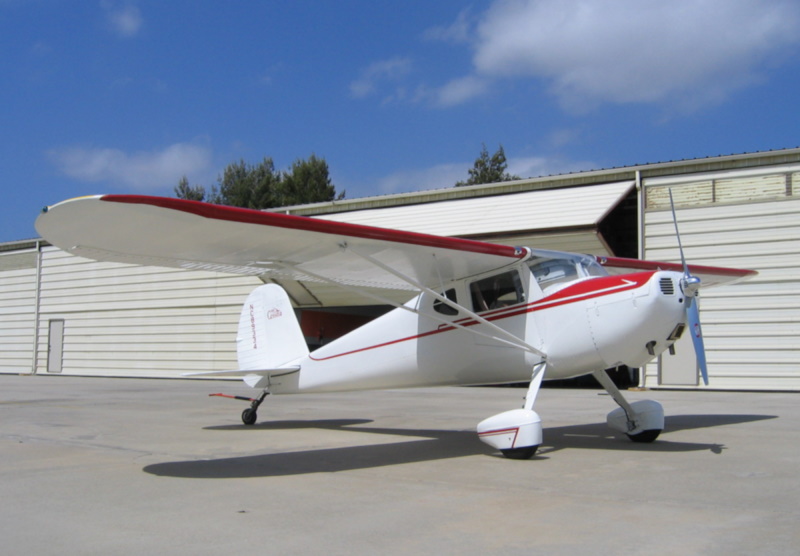
The Model 140 was powered by a Continental C-85-12 or C-85-12F flat-four air-cooled engine, providing 60 kW (90 HP) each and driving a fixed two-blade propeller. A Continental C-90-12F or C-90-14F, with 65 kW (90 HP) was optional. Some were refitted with a Lycoming O-235-C1 engine with 80 kW (110 HP). Fuel supply was 95 liters (25 US gallons).
_____________________________________________________________________
CESSNA MODEL 140:
_____________________________________________________________________
wingspan:
10.01 meters (32 feet 10 inches)
wing area:
14.82 sq_meters (159.6 sq_feet)
length:
6.4 meters (21 feet)
height:
1.91 meters (6 feet 3 inches)
empty weight:
410 kilograms (900 pounds)
MTO weight:
680 kilograms (1,500 pounds)
maximum speed:
195 KPH (120 MPH / 105 KT)
cruise speed:
170 KPH (105 MPH / 90 KT)
service ceiling:
4,725 meters (15,500 feet)
range:
725 kilometers (450 miles / 390 NMI)
_____________________________________________________________________
The Model 140 was produced alongside the "Model 120", which was the same airframe, but lacking niceties -- in particular, it had no flaps. It didn't even have an electrical system, meaning manual starting, and no landing lights; it also didn't have the little "D" windows at the rear of the cockpit. Most were later upgraded to "near-140" standard, though still lacking the flaps.
The "Model 140A" was introduced in 1949, replacing both the original Model 140 and the Model 120. The primary improvement was metal wings; no later Cessnas had fabric-covered wings. The wings also had a single strut, instead of the dual struts of the Model 140; in addition, the landing gear was tilted forward slightly, to reduce the chances of nosing-over if brakes were applied too hard -- this mod had been introduced late in Model 140 / 120 production.
Total production of the series to end of manufacture in 1951 was 4,907 Model 140s, 2,172 Model 120s, and 525 Model 140As -- for a sum of 7,704 aircraft. Many of these aircraft are still flying today.
* In parallel with the Model 140, Cessna introduced the "Model 190", a larger machine of the same general configuration as the Model 140 -- high wing, taildragger landing gear -- but bigger, with no wing bracing, and powered by a radial engine. It was intended as a follow-on to the Airmaster, being targeted at the executive aircraft market, and acquiring the name of "Businessliner" somewhere along the way. It was the first Cessna aircraft of all-metal construction.
Initial flight of the prototype was on 7 December 1945, with certification in 1947. The Model 190 was powered by a Continental R-670-23 seven-cylinder radial, with 180 kW (240 HP) and driving a two-bladed propeller. 233 Model 190s were built, being produced in parallel with the "Model 195" -- which was effectively the same aircraft, but with a Jacobs R-755-A2 engine, providing 225 kW (300 HP), the Model 190 being somewhat underpowered.
_____________________________________________________________________
CESSNA MODEL 195:
_____________________________________________________________________
wingspan:
11.02 meters (36 feet 2 inches)
wing area:
20.26 sq_meters (218.13 sq_feet)
length:
8.33 meters (27 feet 4 inches)
height:
2.18 meters (7 feet 2 inches)
empty weight:
930 kilograms (2,050 pounds)
MTO weight:
1,520 kilograms (3,350 pounds)
maximum speed:
290 KPH (180 MPH / 155 KT)
cruise speed:
255 KPH (160 MPH / 140 KT)
service ceiling:
5,580 meters (18,300 feet)
range:
1,125 kilometers (700 miles / 610 NMI)
_____________________________________________________________________
The Model 195 was followed in 1950 by the "Model 195A", which had a Jacobs R-744-A2 radial, with 185 kW (245 HP). A total of 860 Model 195 / 195A machines were built, late production featuring a close-fitting cowling, a small prop spinner, and larger flaps. The last of the series was the "Model 195B", certified in 1952, which featured an R-755-A2 engine, with 205 kW (275 HP). 100 195Bs were built, giving total production of the series as 233 + 860 + 100 == 1,193 aircraft.

A number of these aircraft were delivered as floatplanes, these aircraft featuring "finlets" near the ends of the tailplane. The US military obtained the Cessna 195 as the "LC-126", with 83 acquired:
A good number of Model 190 / 195 machines are still flying.
BACK_TO_TOP* The two-seat Model 140 led to a four-seat version, the "Model 170", conceived as a "family car of the air". It was of the same general configuration as the original Model 140 -- with fabric-covered wings, and a vee strut wing support -- but stretched, being powered by a Continental C145-2 engine with 110 kW (145 HP), and with more fuel capacity. The concept of selling the Model 170 as a "family car" was a non-starter, but the agricultural industry liked it as a utility machine.
In 1949, the original Model 170 was replaced in production by the "Model 170A", which featured an all-metal wing with no dihedral, tapered outboard of slightly-enlarged flaps, and with a single strut under each wing. It was also fitted with the larger tailfin and rudder of the Model 190 / 195.
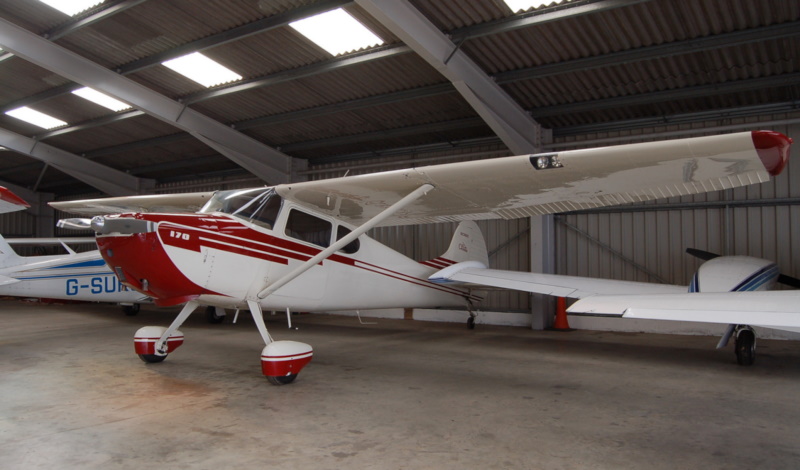
The "Model 170B" was introduced in 1952. It featured a revised wing with dihedral, plus revised flaps -- these being derived from the Cessna "Bird Dog", discussed below. It also had a new tailplane, along with other small refinements. Late production had modified rear windows.
_____________________________________________________________________
CESSNA MODEL 170B:
_____________________________________________________________________
wingspan:
11 meters (36 feet)
wing area:
16.2 sq_meters (174 sq_feet)
length:
7.61 meters (25 feet)
height:
2.01 meters (6 feet 7 inches)
empty weight:
550 kilograms (1,205 pounds)
MTO weight:
1,000 kilograms (2,200 pounds)
maximum speed:
225 KPH (140 MPH / 120 KT)
cruise speed:
195 KPH (120 MPH / 105 KT)
service ceiling:
4,700 meters (15,500 feet)
range:
950 kilometers (590 miles / 515 NMI)
_____________________________________________________________________
The Model 170B led to the "Model 172", introduced in 1955, which was generally the same, but had tricycle landing gear. It would prove extremely popular, and is still being built. The Model 170B then went out of production, over 5,000 Model 170s having been built to that time.
* The initial Model 170 led to a substantially modified derivative, in response to a US Army request for a two-seat liaison / spotter aircraft, for directing artillery fire. The Army had used Stinson and Piper aircraft in the spotter role during World War II, but wanted to obtain something newer and more robust. Cessna submitted the "Model 305A" -- which won the award, to be designated the "L-19A Bird Dog", the name being selected through a contest among Cessna employees. Initial flight of the first prototype was on 14 December 1949, with initial deliveries in December 1950.
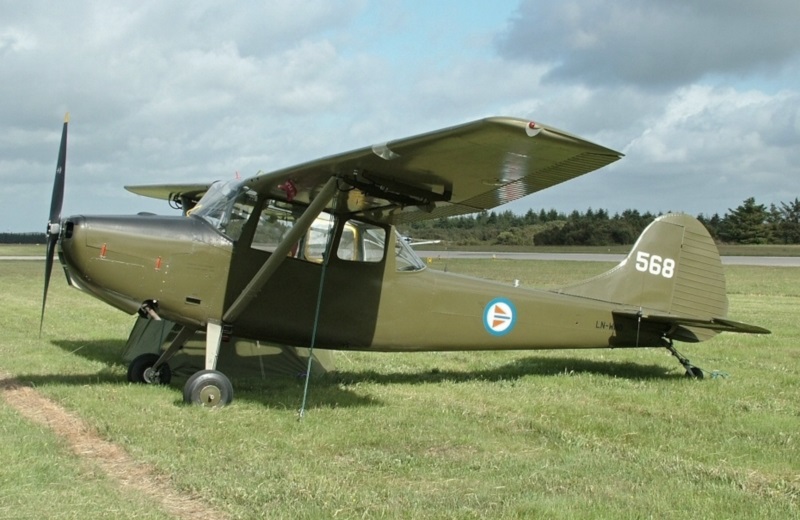
The Bird Dog was very similar to the Model 170A -- all-metal wing with dihedral and single struts, plus the new flaps, which were actually designed for the Bird Dog -- the primary difference from the Model 170A being that the Bird Dog had a modified canopy and cut-down rear fuselage, giving all-round vision, a scheme that Cessna marketing played up as "Onmi-Vision". The cockpit glazing was also modified to improve downward vision and to give a view topside.
The Bird Dog was powered by a Continental O-470-11 engine, with 160 kW (215 HP), and had the Model 195 tail, as well as new flaps to improve short take-off capability. In addition, it had tandem seats, with the pilot in the front and an observer or passenger in the back. Dual controls weren't standard in the baseline version. The doors were wider, to permit loading a stretcher case, with the cockpit featuring support brackets for the stretcher.
_____________________________________________________________________
CESSNA MODEL 305 BIRD DOG:
_____________________________________________________________________
wingspan:
11 meters (36 feet)
wing area:
16.2 sq_meters (174 sq_feet)
length:
7.85 meters (25 feet 9 inches)
height:
2.22 meters (7 feet 4 inches)
empty weight:
730 kilograms (1,615 pounds)
MTO weight:
1,090 kilograms (2,400 pounds)
maximum speed:
210 KPH (130 MPH / 115 KT)
cruise speed:
165 KPH (105 MPH / 85 KT)
service ceiling:
5,640 meters (18,500 feet)
range:
855 kilometers (530 miles / 460 NMI)
_____________________________________________________________________
The Bird Dog found itself in the thick of fighting in Korea, to the end of the conflict in 1953. It proved sturdy and reliable, and its good heating system was appreciated during the Korean winters. A total of 2,486 L-19A Bird Dogs was produced, with 60 going to the US Marines (USMC) under the designation of "OE-1". The L-19A was followed by other variants:
The US Marines obtained a substantially improved Bird Dog, the "OE-2", which was different enough to get its own model number, the "Cessna 321". It featured:
27 OE-2s were built. A number of Bird Dogs were also built by Fuji of Japan under license. In 1962, the Pentagon implemented a common designation scheme for all the armed services, with the Bird Dog designations changing as follows:
The Bird Dog put in extensive service during the war in Vietnam -- the US Air Force being a big user, in the forward air control (FAC) role for the US Air Force, in support of tactical air strikes, as well as search-&-rescue teams. It was also extensively used by the US Army, US Marines, South Vietnamese forces, and the CIA, it appears through the CIA "Air America" front operation. Two were loaned to the Australian Army for service in the conflict -- with one actually built by an Australian ground crew, pieced together from Bird Dogs that had been shot down, crashed, or otherwise been put out of service. One suspects this was done as something of an amusement; this particular aircraft now resides in a museum in Australia.
The Bird Dog was eventually replaced in most of its combat roles by the Cessna O-2 Skymaster and Rockwell OV-10 Bronco. However, the US Army liked its ability to operate out of small, rough airstrips, as well as its relative silence, and ability to get into close to targets for spotting. The Army kept it in service for artillery spotting and utility roles, until its retirement in 1974.
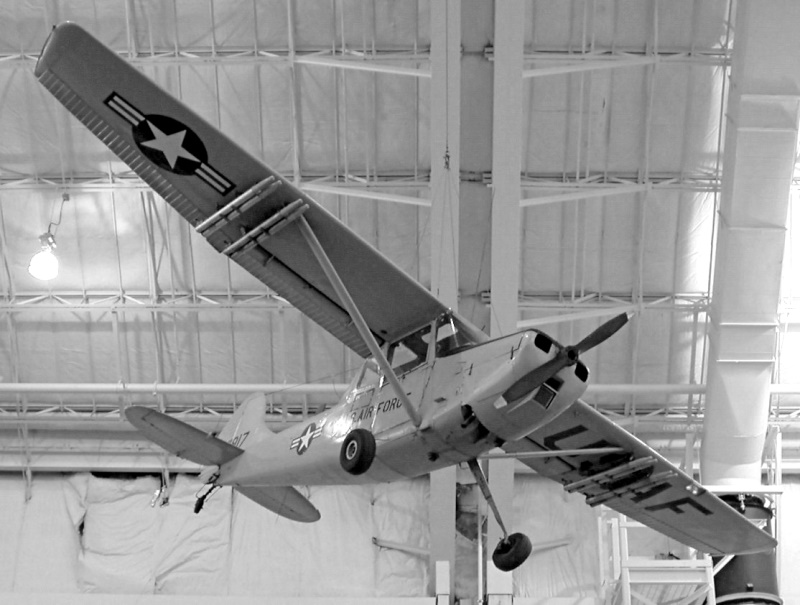
The Bird Dog, however, was highly vulnerable, with 469 lost to all causes during the Vietnam War. The Air Force lost 178; the Marines lost 7; while 284 were lost by the US Army, the South Vietnamese, and the CIA. A good number of the losses were accidents -- the enemy not being inclined to fire on a Bird Dog unless they had to, because an air strike or an artillery bombardment would quickly follow.
* The Bird Dog was widely exported, being used in small numbers by the armed services of Austria, Brazil, Cambodia, Canada, Chile, France, Indonesia, Italy, Japan, Laos, Malta, Norway, Pakistan, Philippines, South Korea, South Vietnam, Spain, Saudi Arabia, Taiwan, and Thailand. It is unclear if Bird Dogs found in France's war in Indochina.
After the Vietnam War, a number of USAF Bird Dogs were provided to the Civil Air Patrol (CAP), the Air Force's civil auxiliary, for use in search and rescue, and other duties. That didn't go well, many CAP pilots not having experience with taildragger aircraft; a good number of CAP Bird Dogs were damaged in take-off, landing, or ground handling accidents. They were gradually replaced by Cessna singles with tricycle landing gear.
Cessna built an agricultural derivative of the Bird Dog as the "Model 325" this machine featuring a chemical hopper in the rear cabin, plus spraybars. Only four were built, details being scarce. Many retired military Bird Dogs ended up on the civilian market. The Ector Aircraft company refurbished a number of them as the "Ector Mountaineer" or -- with the more powerful Lycoming O-540-A4B5 engine -- as the "Ector Super Mountaineer". Hundreds of Bird Dogs are still flying in civil service, with the type seen as a very good sailplane tug, typically with rear-view mirrors attached to the wing struts.
Cessna also built a four-seat utility aircraft -- something of a hybrid of the Bird Dog and Model 170B, with a Bird Dog-like canopy, but four seats -- as the "Model 308", for a US Army requirement, with initial flight of the prototype in July 1951. The Army opted for the De Havilland Canada Otter instead, and only one Model 308 was flown.
* In the early 1950s, Cessna flew a modified Model 170 and L-19 to test out a "boundary layer control (BLC)" system, the two experimental aircraft being designated the "Model 309" and "Model 319" respectively. In BLC, air was blown over the top of the wing and the flaps, allowing shorter take-offs. After some work, the BLC scheme prove effective, but Cessna didn't apply it to a production aircraft.
A number of turboprop conversions of Bird Dogs were flown, beginning with the single "XL-19B", with a Boeing XT-50-BO-1 turboprop providing 155 kW (210 SHP). It was followed by two "XL-19C" machines, with a Continental CAE XT51-T-1 -- a license-built version of the French Turbomeca Artouste turboprop -- also with 155 kW (210 SHP).
The SIAI-Marchetti company of Italy was the enthusiastic builder of "Turbo Bird Dogs". In response to an Italian Army requirement for a short take-off liaison aircraft, SIAI-Marchetti built a modified Bird Dog with an Allison 250-B1C turboprop, providing 235 kW (315 HP), with this prototype machine -- designated "SM.1019" -- performing its initial flight on 24 May 1969.
SIAI-Marchetti won the contest, the company then building 81 "SM.1019A" machines for the Italian Army, these machines being powered by the Allison 250-B15G turboprop -- with the same power ratings as the -B1C variant, but with technical improvements. SIAI-Marchetti also built four "SM.1019B" machines, with the Allison 250-B17B turboprop, providing 300 kW (400 HP).
BACK_TO_TOP* Cessna complemented the Model 170 with a heavier machine of similar configuration, the "Model 180", with first flight on 26 May 1952, and introduction in 1953. The Model 180, which acquired the name of "Skywagon", had the same general configuration as the Model 170B, featuring the same wing, but with a new fuselage and tail -- much like that of the OE-2 Bird Dog, the tailfin being squared-off. The Skywagon introduced an adjustable tailplane for pitch trimming.

The Model 180 was powered by a Continental O-470-A flat-six air-cooled engine, with 170 kW (225 HP). The additional power raised MTO weight by 160 kilograms (350 pounds). Cessna 180s produced between 1953 and 1963 had two side windows, while 1964 to 1981 models had three side windows. The Model 180 proved a very successful "bush plane", sometimes flown with oversized "tundra tires". The utility of the Model 180 was enhanced by options for ski or float landing gear.
About 3,000 baseline Model 180s were built, to be followed by improved variants:
Very late production Model 180Ks could be obtained with a special avionics package, being given the "Model 180 Skywagon II" label. About 6,193 Model 180s were built in all, up to end of production in 1981.
* A derivative of the Model 180 with tricycle landing gear was introduced in 1956, being designated the "Model 182"; it would prove much more popular than the Model 180. However, in 1961 Cessna introduced the "Model 185 Skywagon" -- which was much the same as the Model 180, except more rugged, being specifically intended for the bushplane role.
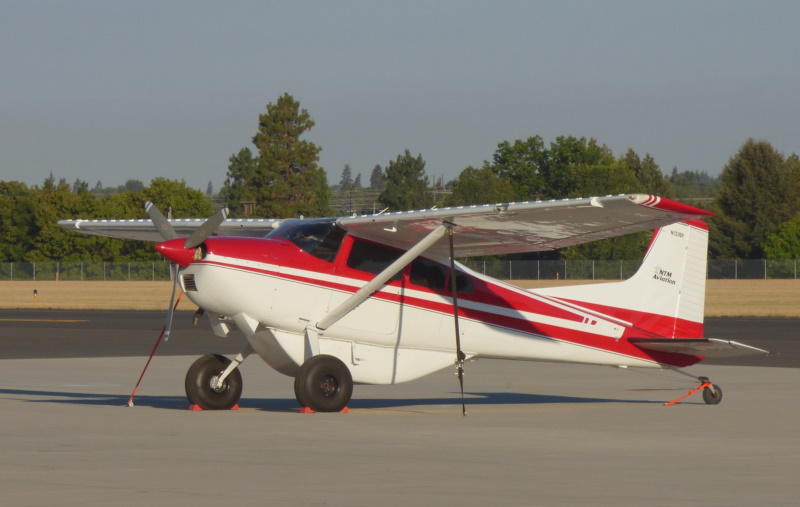
The Model 185 was powered by a Continental fuel-injected IO-470-F engine, with 195 kW (260 HP); six seats were standard, and it had the three windows -- this feature being migrated back to the Model 180G. The Model 185 had a larger tailfin fillet than the Model 180, to improve handling with floats, and could also be fitted with a fiberglass "Cargo-Pack" belly cargo pannier, providing baggage space. The Model 185 could be obtained with an enhanced avionics suite as the "Model 185 Skywagon II".
_____________________________________________________________________
CESSNA MODEL 185 SKYWAGON:
_____________________________________________________________________
wingspan:
10.92 meters (35 feet 10 inches)
wing area:
16.16 sq_meters (174 sq_feet)
length:
7.85 meters (25 feet 9 inches)
height:
2.36 meters (7 feet 9 inches)
empty weight:
770 kilograms (1,695 pounds)
MTO weight:
1,520 kilograms (3,350 pounds)
maximum speed:
285 KPH (180 MPH / 155 KT)
cruise speed:
275 KPH (170 MPH / 150 KT)
service ceiling:
5,455 meters (17,900 feet)
range:
1,575 kilometers (980 miles / 850 NMI)
_____________________________________________________________________
A total of 275 baseline Model 185s was built, being followed by the "Model 180A", with optional long-range tanks. Successive minor improvements were then introduced as the "Model 185B", "Model 185C", "Model 185D", and "Model 185E".
The "Model A185E" was introduced in 1965, being optimized as an agricultural utility aircraft; it was named the "AGcarryall". It was powered by a Continental IO-520-D engine with 225 kW (300 HP). By default, it only had seating for a pilot, with the cabin built as a roll cage. The A185E could be used a personnel or cargo transport -- with a large cargo door as an option -- or as a trainer, and could be used as a crop sprayer in a pinch. A dedicated crop-sprayer configuration was available from 1972.
The refined "Model A185F" was introduced in 1973. About 4,400 Model 185s were built in all, up to end of production in 1985 -- when Cessna stopped building all its piston singles. Some were put back into production in the 1990s, but only the trikes, no taildraggers.
* The Model 180 was popular with military forces, being flown by the armed services of Australia, Cambodia, El Salvador, Guatemala, Honduras, Israel, Laos, Nicaragua, Philippines, Thailand, and Uruguay.
The Model 185 seemed like an even better deal for armed services, and so the US pushed it through the Military Assistance Program -- with the Model 185E given the designation of "U-17A" and the Model A185E given the designation of "U-17B". There was also a "U-17C", described as a four-seater with an IO-470-L engine; it was possibly a light VIP machine.
U-17 users included Argentina, Bolivia, Cambodia, Costa Rica, Ecuador, El Salvador, Greece, Honduras, Iran, Israel, Jamaica, Laos, Nicaragua, Panama, Paraguay, Peru, the Philippines, Rhodesia, South Africa, South Vietnam, Thailand, Turkey, and Uruguay. Although US forces did not use the U-17 as such, the CIA's Air America front did use them in Laos, with their duties including target-marking with smoke rockets.
The Skywagon remains in widespread use, with aircraft often refurbished and given minor updates; three-bladed props are a common mod, as are engine upgrades -- it doesn't appear there are turboprop upgrades -- and various levels of "glass cockpit" upgrades are on offer as well. The Skywagon is likely to stay in service for some time to come.
BACK_TO_TOP* Sources for this document include the online Wikipedia, various air encyclopedias, and volumes of JANE'S ALL THE WORLD'S AIRCRAFT. It is hard to get much background on light civil aircraft.
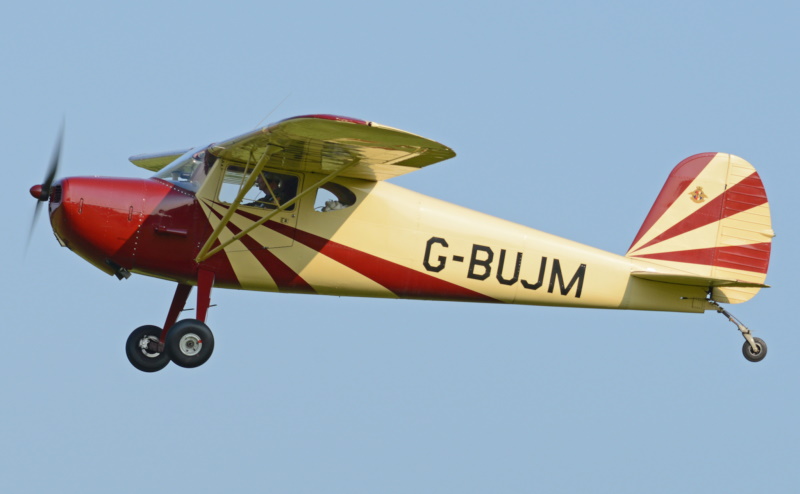
* Illustrations details:
* Revision history:
v1.0.0 / 01 nov 18 v1.1.0 / 01 dec 18 / Brought up to fuller spec. v1.2.0 / 01 feb 20 / Cleanup, improved illustrations. v1.2.1 / 01 dec 21 / Review & polish. v1.2.2 / 01 nov 23 / Review & polish.BACK_TO_TOP
